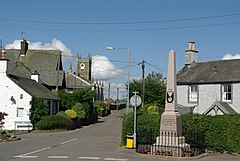Dunscore
| Dunscore | |
|---|---|
 Dunscore village and War Memorial | |
Location within Dumfries and Galloway | |
| Council area | |
| Country | Scotland |
| Sovereign state | United Kingdom |
| Police | Scotland |
| Fire | Scottish |
| Ambulance | Scottish |
| UK Parliament | |
Dunscore (['dʌnskər] / 'DUN-skur', less commonly ['dunskɔ:r] / 'DUN-score') is a small village which lies 9 miles (14 km) northwest of Dumfries on the B729, in Dumfriesshire, in the District Council Region of Dumfries and Galloway, southwest Scotland.
The village consists of about 150 people and has a church, a community run pub, and a hosted post office three times a week.[1] The village hosts a gala event every August.[2]
It is the birthplace of the Church of Scotland missionary Jane Haining, one of only ten Holocaust victims from Scotland.
The Dunscore railway station opened in 1905, and closed to passengers in 1943 and to goods in 1949. The station was on the Cairn Valley Railway which ran to Moniaive from Dumfries.
Craigenputtock Estate is within the Civil Parish of Dunscore.
Etymology
[edit]The name Dunscore is of Cumbric origin, formed of the elements dīn 'fort' and *ïsgor 'fortification, rampart'.[3][4] William J. Watson proposes the meaning "fort of the bulwark or rampart".[5]
The Church
[edit]
There is a parish church of Dunscore.[6]
The long abandoned Dunscore Old Kirk was located near Fardingwell Farm, between Robert Burns' Ellisland Farm and Robert Ferguson's "Isle Tower".
In Thompson's 1832 map, Ellisland was spelt "Elliesland" and was next to Isle Tower.[7]
The 'Laird of Lag's Tomb' is located at the surviving "Dunscore Old Kirk" burial ground, as is the grave of Captain Robert Riddell of Glenriddell, a close associate of Robert Burns.
The church was rebuilt into a heritage centre in 2017, and features information on the Dunscore-born Jane Haining.[8]
Lag Tower
[edit]
Lag (or Lagg) Tower is a ruinous fortification lying on high ground north-east of Dunscore, north of the Laggan Burn. The structure dates from the 15th or 16th century and was originally four storeys high with a walled courtyard at its base. From the 14th Century, the site was the home of the Grierson family, which was responsible for building the tower. Roger Grierson of Lagg was killed at the Battle of Sauchieburn in 1488 and several family members were killed at the Battle of Flodden in 1513. In 1685 Robert Grierson of Lagg was a persecutor of the Covenanters.[9]
References
[edit]- ^ "Village of Dunscore". Retrieved 20 February 2012.
- ^ "Dunscore Village Gala". Retrieved 20 February 2012.
- ^ James, Alan G. (2014). The Brittonic Language in the Old North: A Guide to the Place-name Evidence (PDF). Vol. 2: Guide to the Elements. pp. 144, 215. Archived from the original (PDF) on 11 September 2014.
- ^ James, Alan G. (2013). "P-Celtic in Southern Scotland and Cumbria: A review of the place-name evidence for possible Pictish phonology" (PDF). The Journal of Scottish Name Studies: 56.
- ^ Watson, William J. (1925). "The Celts (British and Gael) in Dumfriesshire and Galloway" (PDF). Transactions and Journal of Proceedings of the Dumfriesshire and Galloway Natural History and Antiquarian Society. Third Series. XI: 147. Archived from the original (PDF) on 31 August 2014.
- ^ "Dunscore Parish Church". Retrieved 20 February 2012.
- ^ "View map: Dumfriesshire. - John Thomson's Atlas of Scotland, 1832".
- ^ "Dunscore Heritage Centre, Dunscore – Historic Buildings & Homes".
- ^ The Castles of Scotland by Andrew Coventry ISBN 1-899874-00-3

